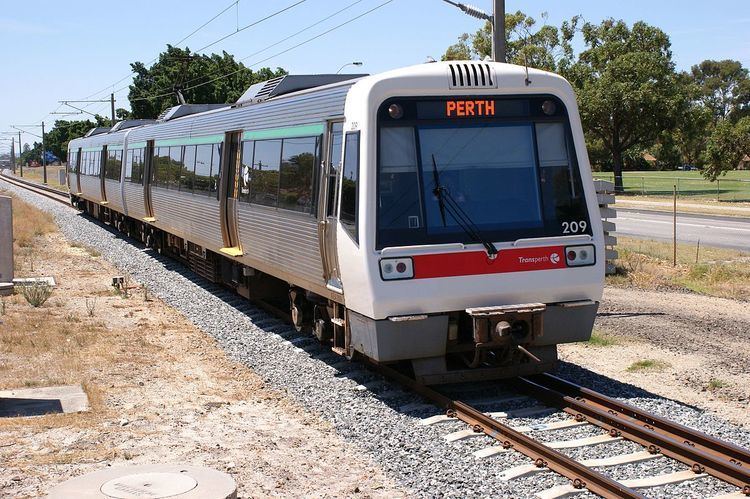Constructed 1991 - 1999 Number in service 48 2-carriage sets | Number built 48 2-carriage sets | |
 | ||
Manufacturer ABB/ADtranz (now Bombardier Transportation) and Walkers (now Downer Rail) Replaced ADK/ADB class diesel railcarsADL/ADC class diesel railcars | ||
The A-series trains are a class of electric multiple unit built by Walkers Limited, Maryborough for Transperth between 1991 and 1999. When introduced in 1991 the A-series trains became the first electric passenger trains to operate in Western Australia and until 2004, were the only type of train in use on the Perth suburban rail network.
Contents
History
Studies for the electrification of Perth's suburban rail network began in 1984 and in 1988 43 two-car electric railcars were ordered from Walkers Limited, Maryborough. Prior to this, Perth's rail transport network consisted of three railway lines radiating from Perth and operated by a mixture of diesel railcars and diesel locomotive hauled trains. In 1979 one of these lines, the Fremantle line, was closed but reopened in 1983 following a change in State Government.
The trains were transported across the continent on standard gauge bogies and converted to Western Australia's 3 ft 6 in (1,067 mm) gauge standard locally. The first set, set 01, arrived in September 1990 and immediately became the subject of industrial action at Westrail's Midland Railway Workshops over a pay dispute and the impending one-man train operation which the new trains would ensure.
Testing of the new trains began soon afterwards and mostly on the Armadale line while the electrification process continued. While the trials were largely successful a number of negative points were noted, not the least of which were braking issues and the creation of a harmonic vibration from the train's bogies which caused nausea in otherwise healthy passengers.
The trains entered revenue service on the 28 September 1991, running Perth Royal Show specials and by April 1992 had virtually taken over the suburban network timetables, with only a very limited number of services still operated by the older diesel trains. The last entered service on 30 October 1992.
Some sets have been named:
The new trains revolutionised the commuter services on the Perth network but their success was marred by project delays and a number of early accidents, some of which involved collisions with motor vehicles at unprotected level crossings, the increased speed and quieter operation as opposed to the older, slower and louder, diesel trains being considered as a contributing factor. In three accidents within the first twelve months of operations three fatalities - all in motor vehicles - were suffered.
Other accidents did not involve loss of life and some, such as a collision between sets while shunting at the train depot at Claisebrook, meant that some sets were mixed while their other half underwent repairs. Several months in 1993, for instance, saw the pairings of AEA226 and AEB339, and AEA217 and AEB326. When repairs were completed the original set combinations were restored.
Additionally a number of teething troubles soon presented themselves, such as braking problems which meant that trains would sometimes fail to stop in the space required and thus not be correctly positioned at the station platforms. These problems were eventually overcome and the type has provided stable service ever since.
In April 1997 a further five were ordered, entering service in 1998/99. These sets introduced longitudinal seating and the current green Transperth livery to the fleet, and with detail improvements including internal information panels, extra security cameras and quieter wheel motors, were subsequently dubbed 'second generation' sets. They are externally identical. Some of the first generation trains were then progressively updated to bring them inline with the more recent units.
Configuration
Each set consists of two semi-permanently coupled cars, designated AEA and AEB, both of which have a driver’s cab and powered bogies. Up to three sets may be coupled together to make a six-car train, although common practice is to operate them only as either two- or four-car set consists. There are currently 48 two-car A-series trains in operation.
Originally, the majority of A-series trains featured two inward-facing rows of bench seats either side of the car forward of the front set of doors and to the back of the rear set of doors, with two-seat rows running down each side of the car in between the doors. In this configuration each car has the capacity to carry 72 seated and 82 standing passengers, giving unmodified the A-series trains a total capacity of 308.
However, most sets have been reconfigured with two inward-facing bench rows running the entire length of the car. This reduces the amount of seats available but increases standing room capacity. Each car has 1-2 wheelchair spaces available.
A-series sets of both generations service mainly the Fremantle, Midland, and Armadale/Thornlie lines. Until early 2011, the Joondalup and Mandurah lines were also serviced by 12 two-car A-series trains at high-demand periods, today two A series sets couple to make a 4 car set that runs Cockburn Central and Whitfords shuttles during peak periods and then runs to Clarkson where it terminates and runs empty to the depot. Six-car B-series trains are used for Butler, Clarkson, Mandurah, and Rockingham services, and as of March 2016, two two-car sets have been fitted with USB charging ports as part of a 6-month trial.
